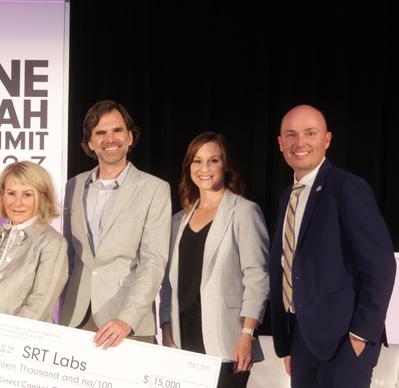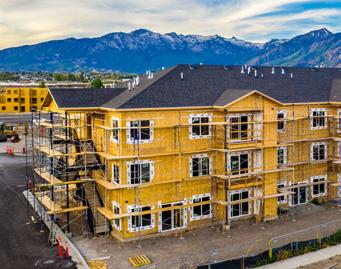


2 TABLE OF CONTENTS
About Us
12 Focus Areas
40 Budget
48 Tax Credits
64 Commissions, Boards & Committees
78 Statute Content Locator




2 TABLE OF CONTENTS
About Us
12 Focus Areas
40 Budget
48 Tax Credits
64 Commissions, Boards & Committees
78 Statute Content Locator


The Utah Governor’s Office of Economic Opportunity (GOEO) prepares an annual report for the Utah Legislature and the public. The report — published annually on October 1 for the previous fiscal year — details the programs, initiatives, and events for which the office is responsible. The 2023 Annual Report represents the period from July 2022 to June 2023, known as fiscal year (FY) 2023.





Under Gov. Spencer J. Cox’s direction, the Governor’s Office of Economic Opportunity provides resources and support for business creation, growth, and recruitment. It also drives increased tourism and film production in Utah. As stewards of the world’s best economy and quality of life, the Economic Opportunity office utilizes federal, state, and private sector resources to administer programs in areas demonstrating the highest potential for economic development and the most opportunity for all Utahns.
 Ryan Starks
Ryan Starks
801-538-8794
ryanstarks@utah.govThe Governor’s Office of Economic Opportunity (GOEO) is stronger than ever. After leadership and organizational changes this fiscal year, we’re even more committed to providing economic opportunities for all Utahns by cultivating prosperity, future-proofing the state’s economy, and working at the speed of business.
Utah’s positive, collaborative, and fast-paced approach to economic opportunities makes it one of the world’s topperforming economies. The state’s economy continues to gain national and worldwide attention. This year, Rich States Poor States ranked Utah with the Best Economic Outlook, U.S. News & World Report ranked our state the No. 1 Economy and Best State Overall, and WalletHub rated Utah the Best State to Start a Business.
We are stewards of one of the world’s top-performing economies and the best quality of life. We take that stewardship seriously.
The Economic Opportunity office backs the state's economic progress with a variety of innovative initiatives and staff members working in multiple areas. Notable accomplishments of our work over the past year include:
• Hiring our first director of the Utah Small Business Credit Initiative (USBCI), a new federal loan program that includes $69 million in funding to expand access to capital for small businesses in Utah, especially in underserved communities.
• Adding the state’s first entrepreneur-in-residence to advise on entrepreneurship education, culture, and resources and
make recommendations on enhancing the state’s entrepreneurship ecosystem.
• Facilitating meetings between the Unified Economic Opportunity Commission and hundreds of stakeholders to discuss top issues facing Utah’s economy. The commission’s recommendations resulted in the approval of over $1.1 billion in new state funding.
• Adding rural outreach managers to cover each area of the state. These managers work with Utah’s rural counties, communities, and businesses, providing economic development resources.
I express my gratitude to the dedicated GOEO employees who wholeheartedly contribute to maintaining Utah's economy as a source of national admiration. I also thank the Legislature for placing its trust in our team to safeguard the state's economy and continue to make it one of the best in the world.
Sincerely,
 Ryan Starks
Ryan Starks

• Support innovation, entrepreneurship, and small business creation and growth
• Promote a business-friendly environment that enables the private sector to create high-paying jobs
• Create policy recommendations that develops, directs, and coordinates Utah’s statewide and regional economic development strategies
• Facilitate alignment between industry and education to train a world-class workforce
• Engage with targeted industries to build strategies that maintain a diversified economy and strengthen the business supply chain
• Utilize sustainable incentives to address challenges in affordable housing, the environment, and transportation, and provide public benefits like infrastructure and workforce development
• Encourage collaboration and partnerships between state and local government, nonprofits, and the private sector
• Provide statewide economic opportunities to support a robust quality of life for all Utahns in both our urban and rural communities
• Expand the tourist experience of Utah’s natural and cultural wonders and promote local film production
• Maintain a database for community reinvestment agencies to track projects and taxing entities
• Offer loans to small businesses through Utah lending partners as part of the State Small Business Credit Initiative
• Create policy recommendations that develop, direct, and coordinate Utah’s statewide and regional economic development strategies
We’re stewards of the world’s best economy and quality of life.

We foster quality economic growth.
The Unified Economic Opportunity Commission (UEOC) develops, directs, and coordinates Utah’s statewide and regional economic development strategies. It informs policy decisions and builds consensus.
Gov. Spencer J. Cox chairs the commission. It includes state legislative leaders, senior leaders from government offices and departments, education officials, key stakeholders focused on housing, cities, and rural counties, and several subject matter experts and non-voting members.

UEOC approved its Utah Economic Vision 2030 plan in September 2021, releasing it publicly in May 2022. It outlines economic development strategies in the following areas:
• Education and the talent pipeline
• Community growth and economic planning alignment
• Economic opportunity for all
• Low regulations/taxes
• Strong targeted industries
• Startup state
• Rural affairs
• International connections
The plan challenges the UEOC with its assessment:
Accommodating growth will remain the state’s most pressing economic issue for the foreseeable future. How Utah coordinates and manages its growth over the next decade will set a pattern and standard for the next century of economic and community planning. In planning for 2030 and beyond, the state’s primary challenge — and opportunity — will be how Utah leaders harness the momentum of America’s fastest-growing economy without overburdening the state’s communities. GOEO is responsible for implementing and executing the plan.
To see what programs and initiatives employees cover, view team headshots, and access email, phone, and LinkedIn profiles, visit our staff directory at econ-opp.fyi/directory.
This table represents full-time GOEO employees — not part-time or intern team members — as of June 30, 2023.


The Governor’s Office of Economic Opportunity offers many programs, services, awards, and resources to help small businesses launch, grow, and mature.
The business services team fosters partnerships with the U.S. Small Business Administration, Suazo Business Center, Women’s Business Center of Utah, and many others to support Utah small businesses through every stage of their business development. Resources include consulting, training, financing options, and other tools to help them succeed.
In January 2023, Gov. Cox appointed Brad Bonham as the state’s first entrepreneur-inresidence. He also serves as a member of the Economic Opportunity office’s board. The business services team supports the state’s entrepreneur-in-residence with a statewide startup initiative to make the entrepreneurship journey hassle-free from a government regulation perspective. The initiative will also make policy recommendations to the Legislature to benefit Utah entrepreneurs.
The Governor’s Office of Economic Opportunity also offers programs and services directly to small businesses, including:

The APEX Accelerator program helps Utah businesses identify and secure government contracts by providing free consulting services that prepare them to compete in the government marketplace. In FY 2023, APEX completed 2,670 hours of counseling, counseled 559 new clients, and helped Utah companies win $1,018,228,273 in federal, state, and local contract awards. APEX

also organized and hosted 76 in-person and virtual events, including the APEX Accelerator Symposium with 220 attendees and the Federal Lands Outreach Conference with 65 attendees.
The business incentives team manages GOEO’s financial incentives for local and out-of-state companies seeking to expand in
or relocate to Utah. Incentives are available to select companies creating new, high-paying jobs that improve quality of life, increase the tax base, and help diversify Utah’s economy. Utah’s corporate incentives are postperformance tax credits. As instructed by the Legislature, the Economic Opportunity office also offers some economic development rebates and grants.
The center works with Utah’s 29 rural counties, communities, and businesses, providing economic development resources. The center administers the Rural Opportunity Program and assists with other programs to help local governments and businesses grow and prosper.
As Gov. Cox’s international outreach team, our international trade team manages diplomatic meetings in Utah and worldwide. They partner with international organizations, including World Trade Center Utah, to promote the Utah business community and recruit foreign direct investment.
The Startup State initiative celebrates, inspires, and empowers Utah entrepreneurs and those who support them. It comprises a statewide entrepreneurship brand and business resource

portal, launching in early 2024. This collaborative initiative encourages entrepreneurs to start businesses in Utah and supports them throughout the lifecycle of their businesses.
This initiative advances economic opportunity, energy efficiency, telecommuting, education, and telehealth services that rely on broadband infrastructure. GOEO works with broadband providers, local, state, and federal policymakers, consumers, community institutions, and other stakeholders to support broadband deployment throughout the state, improve efficiencies, and expand statewide access and usage.
The center assists businesses in Utah with identifying pathways for recruiting and retaining international talent. It coordinates with state and federal government partners on
policies and programs related to immigration. The center also oversees a statewide task force with local officials, business sector representatives, and community stakeholders to advise on areas that promote economic opportunities for immigrants and New Americans in Utah.
The Film Commission supports Utah businesses involved in film, television, and commercial production, from catering to equipment rental, by promoting and incentivizing film production around the state.
The center supports several of the state’s targeted industries. It assists Utah innovators with winning federal research and development dollars through the Small Business Innovation Research (SBIR) and Small Business Technology Transfer (STTR) programs. It catalyzes technology innovation in the state and helps small businesses

compete successfully to win non-dilutive research and development funding.
USBCI is a new federal loan program with $69 million in U.S. Treasury funding to expand access to capital for Utah small businesses, especially in underserved communities.
The Office of Tourism supports Utah entrepreneurs via marketing, stewardship, and destination development. The office curates messaging that inspires visitation, supports local businesses, and strengthens the Utah economy. It helps distribute visitation statewide and supports the responsible discovery of Utah. Partnering with local communities, the office helps enhance and develop local economies to benefit residents and visitors.
This initiative allows businesses to experiment with products, production methods, or services temporarily. It enables entrepreneurs to see if their products work and are valued by customers even when they don’t fit within the state’s current regulatory framework. The office also provides valuable information to policymakers about the appropriate scope and scale of regulation for new products, production methods, or services.
Juab,
Residents and businesses in rural Utah are vital to the state’s healthy and diverse economy. GOEO provides tax credit incentives, grants, and other resources to help local governments and businesses grow and prosper through the Center for Rural Development.
In FY 2023, GOEO and UOT hired four new employees, working remotely from rural
Utah, including two outreach managers, a community and partner relations director, and a grant specialist. These positions will provide mentoring to rural areas and across the state. Their background focuses on supporting and building the economy in rural Utah.
GOEO created the outreach manager service model in the past year. This model has been successful with outreach managers residing in the areas they serve. They provide mentorship to these rural communities, resource information, economic development assistance, etc. The outreach managers are immersed in their communities and dedicated to providing needed resources and economic opportunities for all of Utah’s rural counties.
Examples of Center for Rural Development programs that served rural Utah in FY 2023 include the following:

The APEX Accelerator program helps Utah businesses compete in the government marketplace by providing counseling, workshops, webinars, and networking opportunities.
In FY 2023, APEX Accelerator:
Counseled 101 new clients in rural Utah (18% of all new clients)
Helped Utah Companies receive $84,682,165 million in federal, state, and local contract awards
Held 19 events in rural Utah (25% of APEX events this year occured in rural Utah)
Events from this fiscal year included several Associated General Contractors workshops in St. George and the Manufactured in Southern Utah (MISU) meeting also in St. George. Presentations included the BIG (Beaver, Iron, Garfield) Chamber and the Carbon County Chamber. APEX Accelerator was also a sponsor of the One Utah Summit in Cedar City in October 2022.
U.C.A 63N-4-802
The Rural Opportunity Program was created to include three grant funding opportunities that benefit rural Utah. They are the Rural County Grant, the Rural Communities
Opportunity Grant, and the Rural Employment Development Incentive Grant. Over $11 million from these three grants was awarded in FY 2023. No loans were provided, and that required debt payments for counties. The office found this program strengthened economic opportunity in Rural Utah effectively.
The RCG program awards $200,000 to each of the 24 rural counties in Utah. With the advice of their county economic opportunity advisory boards, each county plans and implements projects and activities that enhance business and general economic development. These projects and activities include business recruitment, development, and expansion. Additionally, workforce training and development, infrastructure, industrial building development, and capital facilities improvements for business development activities occurred. In FY 2023, $4.8 million was distributed to rural counties.
In the third year of administering the Rural County Grant, GOEO saw more engagement and activity from each county’s economic opportunity advisory board. They are contributing more to the economic development decisions being made by county commissions.
One notable challenge is that some counties have trouble expending all the grant funds in a single fiscal year. As a result, GOEO
implemented a new accountability measure that considers funds encumbered for ongoing projects that cross fiscal years.
Economic development projects and activities by rural counties using Rural County Grant funds are:
• Sub-grants to businesses for capital investments and job retention
• Funding economic development professional positions
• Event amenities and venue improvements
• Infrastructure improvements for downtown place-making
• Buy-local sales promotions
• Owner and manager training in practical business skills and customer service
• Business leadership and training academies
• Market research and feasibility studies
The RCOG initiative expands opportunities to rural communities — not only the rural counties but also the cities and towns within them. It is a competitive funding opportunity; each application is scored based on the quality of the application, the proposed budget, the economic development projects and activities proposed, and the purposes, goals, and measurable outcomes related to improving the overall economy. Awards to rural communities may be up to $600,000. In FY 2023, over $6 million was awarded to 18 rural communities for business recruitment, development, and expansion; workforce training and development; and infrastructure, industrial building development, and
capital facilities improvements for business development.
Funding requests by qualified community applicants far exceeded the funds allocated for the grant due to the newly recognized definition of a rural community. As a result, we had more eligible applicants than the previous year. Each award was contracted for up to two years on a 90/10 basis, meaning 90% of the awarded funds are delivered upon award approval, and the remaining 10% will be issued when projects and activities are completed.
Examples of economic development projects and activities by rural communities using Rural Communities Opportunity Grant funds are:
• Development of an Economic Advancement and Innovation Center
• Public infrastructure for downtown business development
• Public plaza development to attract new small businesses
• Rehabilitating a historic business district to support local businesses
• Environmental Impact Study for yearround recreation and tourism
• Training equipment for advanced aviation industry services
• Industrial park development to attract diverse business opportunities
• Historic building renovation for event services

The REDI grant is a direct-to-business opportunity. Growing businesses creating new, high-paying jobs in rural Utah can apply for $5,000 to $6,000 for each new position they create and retain for a 12-month employment period. Under this program, high-paying jobs are defined as jobs that pay 110% of the county’s average annual wage. Contracts for this grant extend across fiscal years, and in FY 2023, $333,000 was paid out to employers for creating 57 rural jobs.
One of the main challenges REDI participants faced during FY 2023 was creating and filling the projected number of positions during the
first six months of their contract periods and retaining those employees. While this challenge resulted from varying circumstances from company to company, each company was invited to reapply in the future.
In FY 2023, 17 businesses applied for a REDI grant. Of those, 7 contracts were executed, with 10 agreements under negotiation. The REDI Grant currently has obligations of $1,154,000 and projects the creation of over 600 new jobs in rural communities over the next few years.
Applications received during FY 2023 came from businesses in the following rural counties:
• Box Elder
• Beaver
• Carbon
• Duchesne
• Grand
• Juab
• Morgan
• Sanpete
• Wasatch
Since this is a post-performance program, reimbursement is made upon verification of new positions created and the annual gross wage of the position at the end of 12 consecutive months.
U.C.A. 63N-4-503
The Rural Coworking and Innovation Center Grant assists in creating facilities designed to provide individuals working within designated rural areas with the infrastructure and equipment needed to participate in today’s online workforce.
Funding previously allocated to this program has been re-directed to the Rural Communities Opportunity Grant (RCOG). The Rural Online Working Hubs Grant Advisory Committee has been dissolved. Future requests for developing Coworking and Innovation Centers will be made through an RCOG application.
In FY 2023, multiple projects continued through the 18-month contracted period. Five awardees who requested reimbursement were paid $310,857 upon completion of their projects. Two more centers will continue in development into the next fiscal year.
Coworking and Innovation Centers are now open in:
• Blanding, San Juan County
• Cedar City, Iron County
• Fountain Green City, Sanpete County
• Green River, Emery County
• Hanksville, Wayne County
• Moab, Grand County
• Monticello, San Juan County
• Orangeville, Emery County
• Panguitch, Garfield County
• Price, Carbon County
• Vernal, Uintah County
Other coworking centers are in development in:
• Junction Town, Piute County
• Roosevelt City, Duchesne County
U.C.A. 63N-2-106(2)
In FY 2023, the GOEO board recommended tax incentives to 10 companies using a change to the Economic Development Tax Increment Financing program focused on

rural Utah called REDTIF. These benefits were provided to companies in eight rural counties. Those 10 companies have a combined capital expenditure of over $1.2 billion in our rural communities and plan to hire 1,380 new fulltime, high-paying jobs that pay at or above the average county wage. The office expects the number of REDTIFs to increase as knowledge of the program spreads.
Rural Counties that had REDTIF projects in FY 2023:
• Box Elder (2)
• Cache (2)
• Juab (1)
• Tooele (3)
• Uintah (2)
GOEO considers all its programs and initiatives crucial to supporting Utah’s small businesses in rural Utah. A few examples include:
• Utah Office of Tourism promotes visitation, tourism, and uniquely Utah experiences across the state
• Utah Film Commission supports and

advances film production throughout the state
• Utah Innovation Center helps small technology businesses secure nondilutive research and development funding
• APEX regional offices support Utah small businesses seeking government contracts
• Utah Broadband Center works to ensure high-speed broadband internet speeds are available throughout the stateespecially in rural Utah
• Business Incentives, especially the state’s tax credit REDTIF program, support rural Utah businesses and companies in rural parts of the state
Produced by Southern Utah University and supported by GOEO, in cooperation with other partner organizations, the governor’s One Utah Summit (formerly known as the Utah Rural Summit) is the premier gathering conference for Utah’s top leaders and decision-makers to discuss rural Utah challenges and opportunities.
Hosted in Cedar City, the summit supports Gov. Cox’s One Utah Roadmap initiative and addresses critical policy and infrastructure needs.
To learn more, visit oneutahsummit.gov or check out One Utah Summit on social media.
The Utah Innovation Center supports innovators in the state by connecting them with a broad range of assets and resources, including the chance to apply for equity-free research and development funding through the federal Small Business Innovation Research (SBIR) and Small Business Technology Transfer (STTR) programs.
The center is proud to have facilitated Utah small businesses receiving over $235 million in direct and follow-on funding since its inception. In addition, the Innovation Center team promotes Technology-Based Economic Development (TBED) efforts by connecting and collaborating with members of Utah’s world-class industry, higher education, and entrepreneurship support organizations.
The Innovation Center is the only state program offering services to support Utah small businesses pursuing SBIR/STTR funding opportunities.
The team offers its services statewide, free of charge, giving Utah’s technology-oriented companies a distinct advantage in today’s competitive environment.
The Innovation Center awarded $95,000 in microgrants to 25 Utah small businesses applying for the SBIR/STTR program, including 10 companies from underserved populations and/or rural counties. Fourteen nonrecourse loans in the amount of $740,000 went to 12 companies competing for Phase II SBIR/STTR awards. Two nonrecourse loans went to a small disadvantaged business, and two went to businesses located in rural Cache and Emery Counties.
A survey was sent to microgrant recipients with a 70% response rate. Of those who responded, two-thirds said receiving the microgrant encouraged them to apply to the SBIR/STTR program, while the other third already intended to apply. Two microgrant recipients won their Phase I awards with seven still pending. Recipients of the nonrecourse loans submit an annual report providing updates on their technology development and solvency of the company.

The Utah Broadband Center (UBC) works to ensure all Utahns have access to reliable and affordable high-speed internet service. It is a resource for the state’s broadband plan, which addresses infrastructure deployment, bandwidth, adoption, and digital inclusion and literacy for the state (Utah Code 63N-17).
The Utah Broadband Center:
• Facilitates the Utah Broadband Alliance
• Convenes the Utah Broadband Center Advisory Commission
• Maintains the statewide broadband availability map
• Administers the Broadband Access Grant program
• Develops a statewide Digital Connectivity Plan
• Administers the federal Broadband, Equity, Access, and Deployment (BEAD) and Digital Equity (DE) grants
The Utah Broadband Center Advisory Commission, established in the 2022 Legislative Session, includes four state legislators and representatives of five state agencies. The commission oversees how the state plans to use federal broadband funding as part of the Infrastructure Investment and Jobs Act.
The UBC is currently completing an updated five-year broadband plan. The plan is informed by national, state, and local data, including feedback from a listening tour conducted this year with community leaders, government and nonprofit organizations, tribal leaders, and individuals from all 29 Utah counties and eight federally recognized
tribes. Additional outreach efforts included oneon-one meetings with approximately 50 local internet service providers. The plan will guide the deployment of nearly $317.4 million in BEAD funds allocated to the state to facilitate increased availability, accessibility, and affordability of highspeed internet for the benefit of all Utahns.
In partnership with the National Telecommunications and Information Administration, UBC hosted a statewide broadband stakeholder event called “Internet for All: Utah Broadband Confluence.” The June event took place at the Utah Valley Conference Center in Provo. It brought together more than 300 attendees representing various entities to share progress and goals to narrow and close the digital divide.
A total of 33 Broadband and Digital Access Planning grants were awarded to local and statewide entities to complete local broadband and digital access strategic plans, amplifying the state’s BEAD and DEA efforts. Eighteen of the awards were given to entities in rural Utah (14 of the Local Broadband Planning Grant awards and four of the Digital Access Planning Grant awards). They seek to address community vision, partnerships, gap assessments, and other components of the community.
This year, the Digital Access office was established within UBC with two new full-time employees. They work hand-in-hand with the UBC team to ensure all Utahns can participate fully in the modern world with affordable, reliable, accessible broadband.
The Business Incentives team helps accelerate business growth and job creation through sustainable, targeted expansions and relocations. The team's primary economic development tool is Utah’s Economic Development Tax Increment Financing (EDTIF) program. Through this program, financial incentives are available for select companies that:
• Create new, high-paying jobs
• Help improve the standard of living
• Increase the tax base
• Attract and retain top-level management
• Diversify the state's economy
Using this criteria, the Business Incentives team recommends financial incentives for local and out-of-state companies seeking to expand or relocate to Utah. The GOEO board votes on all proposed incentives in a public meeting. The office’s executive director provides the final signoff on all awarded incentives.
Incentives are offered as tax credits or grants. They’re disbursed only after the company has met contractual performance benchmarks, including job creation, capital expenditure, and payment of new state taxes.






Since its inception in 2005, approximately two-thirds of the companies participating in the state’s tax credit incentive program instead of Utah-based companies.

Projections based on the FY 2023 EDTIF/ REDTIF approvals
• 16 participating companies
• Over $12.3 billion in projected capital investment
• Over $574 million in projected new state revenue
• 3,630 new jobs created
• Over $4.08 billion in projected new state wages in the next 20 years
Trends for the year included projects in locations away from the Wasatch Front and into rural Utah, and investments in industries such as technology and automation.
Thanks to modifications of the EDTIF program for rural areas, the Rural Economic Development Tax Increment Financing (REDTIF) tax credit program, projects located in rural areas qualified for more significant incentives. With this tool, the state has seen unprecedented economic opportunities flow to its more rural communities, with 10 of the 16 projects approved this year choosing a rural
site. The projected capital investment in rural Utah from announced projects in FY 2023 amounts to more than $1.2 billion, more than double the capital investment rural areas saw in 2017 through 2021 combined.
These successes were made possible by a team that includes many external GOEO partners. For example, the office’s partnership with the Economic Development Corporation of Utah (EDCUtah) remains critical for managing the state’s new project funnel, coordinating outreach, and working with local entities.
The Economic Opportunity office’s International Trade and Diplomacy team partners with international organizations in Utah, including the World Trade Center Utah (WTCU), to coordinate the state’s international business promotion activities, including trade missions, trade shows, and business workshops.

In FY 2023, GOEO and WTCU hosted and organized events with more than 50 dignitaries and international representatives. Many of these diplomatic visits included business roundtables that allowed Utah businesses to meet diplomats and learn about expanding into global markets. In addition, many of these diplomats met with state leadership to strengthen international relationships.
The International Trade and Diplomacy team also works to increase Utah exports to foreign countries and promotes foreign direct investment in Utah. Through the office’s partnership with WTCU, 398 companies received assistance in utilizing international services in 2022. In FY 2023, GOEO and WTCU organized two governor-led trade missions,
including one to Israel and the United Arab Emirates and one to France and the United Kingdom. These trade missions were attended by businesses and policy leaders alike, with the latter joining as part of coordinated efforts of the UEOC. The trade mission to the Middle East had a business focus on aerospace and defense and life sciences. The legislative focus was on water, transportation and growth, technology, innovation, and investment. The trade mission to Europe had a business focus on life sciences, consumer goods, and innovation and a legislative focus on growth and transit, nuclear energy development, technology, innovation, and investment.
Gov. Cox’s International Trade and Diplomacy team communicates and coordinates with foreign government agencies to establish lasting international relationships for the state. In FY 2023, the team helped facilitate two trade agreements with foreign counterparts that will help increase international engagement for Utah. Gov. Cox signed a letter of intent with Région Sud of France, supporting tourism and collaboration in new technologies, innovation, and healthcare. Utah became the fifth state to sign a memorandum of understanding with the United Kingdom, formalizing the relationship and focusing on our priority areas, including targeted industries, academic cooperation, supply chain resilience, and addressing further trade barriers.
There are no recommended changes for GOEO’s International Trade and Diplomacy office.
Utah works to create sustainable advantages around emerging and mature workforce sectors by convening constituents and organizing strategies to support and build specific industries in its robust, diverse economy. Utah has five targeted industries selected for their current and potential contributions to its growing economy.
Utah’s advanced manufacturing industry includes cutting-edge companies dedicated to expanding the advanced materials, manufacturing, technology development, and design sectors. Manufacturing is one of Utah’s largest industries, making significant GDP contributions to the state. In 2022, the industry:
• Provided 5.7% of total employment
• Paid 5.6% of total earnings
• Produced 6.2% of Utah’s gross domestic product
• Employed more than 19,000 Utahns
The aerospace and defense industry in Utah includes many widely known companies. It also includes specialized companies contributing to the commercial and defense supply chains. Utah's aerospace industry accounts for over 1,500 companies and organizations, 31,000+ jobs, and is projected to grow more than 12% in the next decade.
Utah’s financial services industry and workforce are well-known for their strength and excellence. This sector includes commercial and industrial banks, credit unions, fintech businesses, insurance organizations, and other financial services enterprises. This sector experienced
employment growth of 14.1% over the past five years, and Utah’s 15 industrial banks held $200 billion in assets in 2022.
Some of Utah's largest employers are healthcare companies, such as Intermountain Healthcare and University of Utah Health. Utah's life sciences industry develops, manufactures, and distributes the pharmaceuticals and medical devices that make modern healthcare possible. According to recent statistics, Utah's GDP generated by the life sciences industry now approaches $18 billion. Utah has been the fastest-growing life sciences community in the country from 2012 to 2021, growing at 5.7% compared to an average of 3.6% of the other top 20 states in life sciences.
Since the 1980s, Utah has been home to cutting-edge information technology and software companies. Today, Silicon Slopes is a household name. Utah’s tech industry is an economic driver, with over 9,500 IT-related companies and organizations calling Utah home and job growth averaging 5% per year (2012 to 2022). In 2022, tech jobs in Utah grew by 6.7%, equating to more than 14,000 people employed in the industry.
The Utah Office of Tourism plays an integral role in the Governor’s Office of Economic Opportunity by stimulating traveler spending in the state. It partners with local communities to market the state and to enhance and develop visitor economies to benefit residents, visitors, and stakeholders. The office created the Red Emerald Strategic Plan to guide these efforts, identifying five imperatives for promotion and product development:
• Continue Powerful Branding
• Prioritize Quality Visitation
• Enable Community-led Visitor Readiness
• Distribute Visitation
• Improve Organizational Effectiveness
The FY 2023 marketing campaigns attracted travelers willing to spend more money and participate in more activities. The campaigns also educated visitors on how to travel responsibly and engage thoughtfully in our local communities. The Southern Utah advertising campaign influenced more than 777,000 Utah leisure trips and around $1.6 billion in visitor spending. The ski campaign also performed well, influencing about 453,000 trips, resulting in approximately $1.17 billion in visitor spending.
As international travel continues to rebound from pandemic impacts, the international team has focused on ensuring Utah remains top of mind with international operators. This year, the tourism team launched its Utah Specialist Academy Platform, a Utah travel training program for tour operators, travel agents, and other travel trade partners worldwide. The
team also hosted 30 familiarization (FAM) tours and press trips in Utah, inviting international journalists and tour operators to experience the state’s unique offerings firsthand. They also participated in eight international missions and global trade shows. These included:
• Brand USA Travel Week European Union
• Toronto Ski Show & Canada Media Mission
• Netherlands/Belgium Sales Mission
• Australia/New Zealand Sales Mission
• India Sales Mission
• Brand USA Mexico Mission
• Governor’s Paris and London Trade Mission
The office continued to engage and support local communities and destinations through several programs and grants. Fifty-nine grants were awarded in FY 2023 for $5.2 million from the Traditional Cooperative Marketing Program. Of these grants, 39 were awarded to organizations in rural communities throughout Utah. Since 2005, the Cooperative Marketing Program funded 944 applications totaling $53.4 million and extended the state’s brand to $106.9 million in out-of-state marketing dollars.
The office completed its second phase of a statewide resident sentiment survey conducted by the Kem C. Gardner Policy Institute to gauge resident attitudes regarding travel and tourism. Most Utah residents have favorable views of tourism, but there are concerns about housing prices and environmental impact — particularly in communities that serve as gateways to Utah’s most visited attractions.


The Utah Film Commission plays a vital role in the success of the Governor’s Office of Economic Opportunity by promoting the state as a destination for film, television, and commercial productions. Film production creates jobs in the creative sector while supporting local businesses and encouraging tourism across the state.
In FY 2023, the amended Utah Motion Picture Incentive Program, designed to attract higherimpact film and television productions to Utah’s rural communities, added additional tax credits available for productions that film at least 75% of their production days in a rural county.
The focus on film production in rural Utah is already demonstrating success. In FY 2023, the GOEO board approved 10 projects for the rural incentive using this new tax credit. These projects spent an estimated $93 million in rural Utah, including Carbon, Emery, Grand, Kane, Juab, San Juan, Summit, Tooele, and Wasatch Counties.
Film production continues to be a reliable economic driver that impacts the entire state. In the last 10 years, Utah’s film incentive created $604 million in direct spending by productions and related vendors. A 2021 study from Olsberg SPI commissioned by the Motion Picture Association of Utah revealed how valuable Utah
film production has been to the state. The study found that for each tax dollar spent on the tax credit, Utah's economy receives $7.
The Utah Film Commission also serves as a liaison to the broader entertainment industry by supporting local film events and working with higher education to create workforce training opportunities around the state.
• $18.79 million in state film incentives was awarded in fiscal year 2023 to 17 productions shooting in Utah, including a mix of local and out-of-state feature films and TV series, yielding a total estimated spend of $140 million
• 63% of all Utah filming locations were in rural counties
• Twenty Utah communities were certified by Film Ready Utah to support productions and encourage economic impact across communities
• A 2023 SMARI study estimated $600 million per year in film-motivated tourist spending in Utah over 10 years, with 37% of visitors indicating that a film or television series was among the primary motivators for visiting a particular destination in the state

The Office of Regulatory Relief administers a general regulatory sandbox created by the Utah Legislature in 2021. The regulatory sandbox gives companies one year to experiment with new and innovative ideas without the burden of regulatory barriers. Possible oneyear extensions are also available. Companies with products, services, or business models that don’t neatly fit into the state's current regulatory framework can submit ideas they would like to test in the sandbox to the Office of Regulatory Relief.
As a sandbox participant tests its idea, state regulators collect data about how well the business and idea work without burdensome regulations. Regulators evaluate the experiment's results at the end of the predetermined term. Once regulators have gathered all the facts, they provide them to the Legislature.
The Regulatory Relief office also invites residents and businesses to make suggestions regarding laws and regulations that could be modified or eliminated to reduce their regulatory burden. Please send feedback and suggestions to regrelief@utah.gov.
During FY 2023, the Regulatory Relief office had two participants graduate from sandbox participation:
Homie Title was the first participant in the general regulatory sandbox, representing the title insurance industry. Homie Title requested a waiver of Utah Code Ann. § 31A-23a-1003(1)
(b), which requires that title companies have at least 30% of their annual title insurance business come from an unaffiliated business as that term is defined in Utah Code Ann. § 31A-23a-1001(1). They proposed an offering to simplify and streamline buying and selling homes and reduce additional fees and commissions. On Feb. 23, 2022, Homie Title began its demonstration period, which ended on Feb. 22, 2023. During this time, Homie Title completed approximately 1,401 closings in Utah and saved Utah consumers an estimated $14,000,000 in real estate costs by using Homie’s one-stop shop model. The Division of Real Estate reported two complaints during the demonstration and did not recommend a law change.
Representing the towing industry, TowPro is a business operating a web-based application designed to innovate how public safety dispatchers and towing companies communicate and automate the dispatch process. By automatically rotating between towing companies until a tow is accepted, this platform reduces response times, clears crashes more quickly, and reduces the risk of secondary accidents. On July 5, 2022, TowPro began its demonstration period and received a waiver of Utah Code Ann. § 72-9603 (16), which regulates a tow truck motor carrier’s ability to charge a fee to a vehicle owner or pass along fees to a vehicle owner when that fee is charged in response to (A) a peace officer dispatch call; (B) a motor vehicle division call; and (C) any other call or request where the owner of the vehicle, vessel, or
outboard motor has not consented to the removal. Utah Code Ann. § 72-9-604 was also waived concerning this offering, which prohibits political subdivisions from charging fees related to dispatch costs associated with a towing rotation. This business provides services to municipalities and political subdivisions within a given dispatch area, and during the demonstration, 3,712 tows were completed. Some jurisdictions reported that TowPro cut the response time for a tow truck to get on the scene in half. During the 2023 Legislative Session, SB 27 passed and amended the provisions to the fees related to tow truck dispatch services.

The Utah Small Business Credit Initiative (USBCI) is the state's name for the federal State Small Business Credit Initiative (SSBCI) program. It helps expand access to credit through two lending programs: the Capital Access Program and the Loan Participation Program.
Provides lenders loss protection to help them fund projects they typically may not fund.
Purchases up to 50% of a small business loan from a lender; provides a low-interest rate for the state-owned portion of the loan to lower the current market rate.
Throughout FY 2023, the Economic Opportunity office worked with the U.S. Department of the Treasury to receive federal approval for Utah's $69 million grant, which
funded the state's USBCI program.
The state's Capital Access Program and Loan Participation Program opened in early 2023, allowing banks, credit unions, community development financial institutions, and revolving loan funds to apply to participate as program lenders.
The office built out program systems, contracts, and compliance checks and balances for the new loan program, then rolled out USBCI to participating lenders.
The Economic Opportunity office looks forward to deploying capital through these important lending programs during FY 2024.
Next year's annual report will include an accounting of fund expenditures and an evaluation of the effectiveness of the two USBCI loan programs.

The Legislature created the Utah Immigration Assistance Center during its 2021 general session with the passage of HB 404. In the 2023 session, its name was changed to the Utah Center for Immigration and Integration to reflect the broader immigrant integration strategies with SB 53.
The center assists individuals and businesses in navigating pathways to recruit and retain global talent. It also engages with state and federal government partners to convene, facilitate, and advise on immigrant integration strategies that promote economic opportunity for New Americans or foreign-born individuals living in Utah.
New Americans are vital to the labor market and contribute to economic growth. In Utah, New Americans comprise 11% of the labor market as essential workers and credentialed professionals, as opposed to 17% nationally. The Utah Center for Immigration and Integration works to increase pathways for New Americans in Utah in targeted industries where numerous initiatives increase Utah’s immigrant labor participation.
One of the center's initiatives is the state's New American Taskforce, led in partnership with The Center for Economic Opportunity and Belonging. In 2022, it produced a report and recommendations on a comprehensive strategy that maximizes economic opportunities, social inclusion, and civic potential for New Americans while reinforcing an environment of belonging in Utah.

The New American Task Force surveyed over 6,500 internationally trained professionals and Utah newcomers to help identify ways these workers can contribute to Utah’s workforce. In addition, the center convenes a group of over 120 stakeholders statewide representing nonprofits, businesses, industry associations, state and local government, faith-based communities, and individuals to inform and make recommendations on immigration and integration, emphasizing workforce and economic opportunity.
In FY 2023, the center provided resources and presentations to over 100 businesses and individuals on global talent and employmentbased visa pathways. It hosted four convenings in Salt Lake City, Ogden, Moab, and St. George. It also hosted a symposium in Logan that brought together national partners and local practitioners on immigrant integration and produced a report on the economic contributions of New Americans in northern Utah.
Recommendations for the Utah Center for Immigration and Integration include strategic investments to sustain the center and the recommendations of the New American Task Force.

As outlined by the Legislature, GOEO maintains a database for community reinvestment agencies to track the financial details for each project area and the taxing entities with which they partner. When a community reinvestment agency complies with statute, it allows GOEO to create and provide a database to track and publicly make available information, including property valuations, funds collected, balances, and amounts paid to other taxing entities.
As of Sept. 1, 2023, GOEO validated that 57 entities provided complete reports, 15 entities completed partial reports, and three entities did not participate in providing a report.
The Utah Redevelopment Agency database is available at goedcommunity.utah.gov/RDA/s
The Governor’s Office of Economic Opportunity compliance team reasonably assures that companies receiving a tax credit or cash payment have met legislative, regulatory, and contractual requirements before receiving incentives.
The team includes members with accounting, finance, and business economics training and experience. It uses best practices to collect, verify, and store statutorily required performance metrics. The team strives to ensure the proper use of taxpayer funds.
GOEO manages and executes tax incentives, pass-through appropriations, and other economic incentive contracts. With assistance from the state attorney general's office, GOEO ensures that agreements capture legislative direction and intent and are legally sound. Awards are typically post-performance and require each company’s participation through accurate reporting, assisted by data-sharing agreements with the Utah Department of Workforce Services and the Utah State Tax Commission as necessary.
GOEO utilizes the Salesforce platform to create contracts, collect electronic signatures, retain relevant documents, and manage contracts. Because of increased legislative activity, the office processed 470 contracts in FY 2022 and 480 contracts in FY 2023.


Includes one-time and nonlapsing/carryforward balances
** ***
Other includes CARES Act Funding
Restricted fund balances reported separately (see FY 2023 Fund Budget)
Includes one-time and nonlapsing/carryforward balances Operational fund balances reported separately (see FY 2023 Operations Budget)

GOEO manages the Legislature-funded Industrial Assistance Account. It has three purposes:
1. Provide grants and loans to entities that provide a unique economic opportunity and contribute to the state’s financial well-being. The unique opportunity must be in concert with other state, federal, or local agencies’ economic benefits and act in concert with free-market principles.
2. Allocate funds to reimburse for-profit businesses for the costs incurred to recruit, hire, train, and hire employees in a newly created job.
3. Beginning June 1, 2022, it can grant funds to an entity offering technical assistance to a municipality concerning housing, transportation, and growth planning.

• IAA expense is shown on a cash basis from July 1 to June 30 each year.
• In FY 2022, the RFT program closed with the final payment being made in FY 2023.
• In FY 2022, the division of funding was changed to put all remaining available towards economic opportunities.



U.C.A 63N-3-10
The $4.5 million Economic Assistance Grant assists Utah businesses that promote and support economic opportunity and provide a service related to industry, education, community development, or infrastructure. The grant funded 31 projects in FY 2023, allocating the $4.5 million appropriation.
U.C.A. 63N-3-902
This $10 million program may award grants to Utah-based businesses to implement strategic and innovative solutions addressing air quality or water conservation. Projects awarded funding work with the Kem C. Gardner Policy Institute at the University of Utah, the Institute of Land, Water, and Air at Utah State University, or the Bingham Research Center at Utah State University for tracking and final reporting to assess outcomes and viability. Projects must be completed by July 1, 2026. The grant funded 11 projects in FY 2023, allocating $9.7 million of the appropriation.
The $10 million Manufacturing Modernization Grant incentivizes Utah businesses to modernize, establish, relocate, retain, or develop manufacturing in the state. Its goal is to modernize Utah companies’ manufacturing, increase supply chain, and lessen American dependence on foreign manufacturing. The grant funded 22 projects in FY 2023, allocating the $10 million appropriation.

The Economic Development Tax Increment Financing (EDTIF) program helps foster and develop key industry sectors in Utah, provides additional employment opportunities, and improves the state’s economy.
The Rural Economic Development Tax Increment Financing (REDTIF) tax credit program was introduced in fiscal year 2021. REDTIF refers to rural modifications of the EDTIF program that allow projects located in rural areas to qualify for more significant incentives.
The program offers tax rebates to companies of up to 30% in urban areas and 50% for specific rural areas of new state taxes paid for up to 20 years. These companies must create at least 50 jobs that pay 110% of the county average for urban areas and 100% for rural areas.
Throughout the remainder of the report, both programs will be referred to as the EDTIF program for simplicity.
EDTIF contracts are post-performance, only providing a refundable state tax credit for new state revenue created by the company if the company meets at least 50% of its promised obligations of creating high-paying jobs.
The number of approved incentives for the EDTIF program was 16. In FY 2022, 27 companies received approval from the GOEO board to participate in the EDTIF program.
The EDTIF participants this fiscal year are collectively projected over the next 20 years to create:
3,630 High-paying jobs
$12,347,247,968 Capital investment $574,641,262 State tax revenue
$4,083,879,940 In-state wages
With this tool, the state has seen unprecedented economic opportunities flow to its more rural communities. For example, the projected capital investment in rural Utah from announced projects in FY 2023 amounts to more than $1.2 billion.
As required under 63N-2-106 (3), the office shall audit the EDTIF program, study the tax credits, and make recommendations on whether the tax credits should be continued, modified, or repealed every three years.
The audit was completed in late August 2023 and was conducted under agreedupon procedures by Tanner LLC. Between July 1, 2019, and June 30, 2022, our office issued 145 tax credits/cash rebates totaling
$74,988,000. The sample included reviewing 80 of the 145 tax credits/cash rebates provided. All reviewed assessments showed that job growth calculations were met per the contract terms. Three non-material exceptions were included in the findings, including two overpayments, which resulted in credits provided in excess of $6,556 and $32,208 and will be recovered by reducing a future award in the next post-performance review.
The program was also evaluated to calculate the total return on investment (ROI) for fiscal years 2022, 2021, and 2020 by gathering information on new state of Utah revenues, administrative expenses, and the total decrease in tax revenues (tax credits) resulting from EDTIF tax incentives. The percentage of new state of Utah revenues was also calculated in comparison to administrative expenses and program tax credits.
The ROI of the program was found to be 454%, 384%, and 415% for fiscal years 2022, 2021, and 2020, respectively, as compared to 380%, 363%, and 339% for the previously audited report for fiscal years of 2019, 2018, and 2017, respectively.
The office recommends the EDTIF program continue to operate.
Companies offered an incentive under the EDTIF program may enter into a contract to provide a report of employees and state taxes paid. These reports are reviewed annually by our office before the issuance of a tax credit. These post-performance reviews are called assessments. Assessments typically lag by two calendar years to allow time for corporate filings and tax reporting. Completion of an assessment is contingent on the time and accuracy of the
company-provided data. An assessment's completion date may impact data reported by the program in year-over-year comparisons.
During the last reporting period of the calendar year 2021, the program completed 40 currentyear assessments, 38 prior-year assessments, and three previous-year adjustments.
Companies in information technology and financial services led the types of companies assessed during this period.
Since the EDTIF program’s 2005 inception, GOEO’s compliance team has assessed 145 companies and verified the creation of 47,504 new full-time jobs.
For companies that did not have an audit year assessment, we assume there was no increase or decrease in employee count for reporting purposes. This data represents annual incremental increases or decreases; the years can be added to create the total cumulative job count.
For assessments completed for CY 2021, new high-paid employees who received a paycheck above 110% of the county average wage were identified across all areas of the economy.
GOEO’s compliance department receives many requests to calculate new state revenue for companies with an EDTIF award. New state revenue is calculated using paid and remitted employee withholdings, sales and use tax, and corporate tax that has increased since receiving GOEO board approval, as verified by information from the Utah State Tax Commission.
A percentage of these new state revenues can be credited to the EDTIF program if the company meets its contractually defined number of new, high-paying jobs. The chart below shows the percentage by type of cumulative new state revenue and new state revenue for CY 2021.
Over the program’s history, EDTIF-assessed companies have created $986.5 million in new state revenue and $732.4 million in new state revenue after tax credits.
The difference in these two amounts represents tax credits awarded by the percentage of new state revenue incentivized by the EDTIF program of $254 million. The award percentage has been set in statute not to exceed 30% for urban counties and 50% for rural counties
$10,846,194 $36,834,767 $25,988,573
2011 $11,767,769 $45,384,076 $33,616,307
2012 $15,207,871 $49,714,555 $34,506,684
2013 $15,681,109 $53,131,241 $37,450,131
2014 $17,620,965 $60,512,550 $42,891,585
2015 $19,504,481 $69,431,582 $49,927,101
2016 $18,187,727 $71,382,954 $53,195,227
2017 $20,811,974 $85,334,973 $64,522,999
2018 $24,123,692 $106,766,606 $82,642,914
2019 $32,707,175 $131,890,915 $99,183,740
2020 $13,965,011 $70,784,350 $56,819,340
2021 $17,341,754 $81,819,784 $34,478,030 $254,058,810 $986,501,901 $732,443,091

Enterprise Zones are economic areas designated by local governments and approved by GOEO. Eligible businesses within Enterprise Zones can apply for state income tax credits to invest in depreciable assets, including machinery and equipment; to help create new, above-average wage jobs; and to rehabilitate older facilities.
The Center for Rural Development works with the GOEO compliance team to review and approve business applicant claims for Enterprise Zone Tax Credit certificates. The center and compliance team also cooperate with the Automated Geographic Reference Center to update and refine all Enterprise Zone designation maps throughout the year.
The program actively issues tax credits incentivizing private investment, but activity in FY 2023 is slightly lower than in FY 2022. The decrease in activity may relate to legislative modifications that commenced in FY 2021 for the program. The tax credit percentage rate was reduced from 10% to 5% on qualified depreciable assets, and entities whose primary business is residential rental property are no longer eligible for tax credits. Additionally, no new Enterprise Zone designation applications were accepted after Dec. 31, 2020, ultimately leading to the program’s sunset.
In FY 2023, 903 Enterprise Zone Tax Credits were issued, compared to 947 in FY 2022. Applications are made available every January for the previous three calendar years. Of these 903 issued tax credits, around two-thirds were issued for the 2022 year and one-third for prior periods in the calendar year the depreciable asset(s).were placed into service, as reported in the table below.

The Hotel Convention Tax Incentive encourages the development of co-located hotels and convention spaces in Utah. It provides a postperformance tax rebate of up to $75 million for up to 20 years.
In October 2018, the GOEO board approved the developer, Salt Lake City CH, to receive a post-performance tax credit to build a new Salt Palace Convention Center hotel in Salt Lake City. The hotel broke ground in the spring of 2020. When completed in the fall of 2022, it provided approximately 700 rooms and added 62,000 square feet of meeting space to attract larger conferences, meetings, and conventions.
With the assistance of a third-party auditor, GOEO and the Utah State Tax Commission are actively validating and transferring the rates of state, county, and local sales taxes paid on the materials used in the hotel’s construction to the Convention Incentive Fund. GOEO and the Utah State Tax Commission must successfully validate and process $3.8 million in sales tax before the hotel receives an incentive. After reaching that amount, the hotel will receive an incentive equal to 95% of the sales tax paid,
with 5% going to the Stay Another Day and Bounce Back funds.
GOEO and the Tax Commission processed sales tax claims for nine quarters, ranging from first quarter CY 2020 to first quarter CY 2022. These claims total $3,768,582.
In the fall of 2022, GOEO and the Salt Lake Convention Center accepted applications through a Request for Information process to help determine how to best administer the Hotel Mitigation Fund. Affected hotels will be provided an application starting in August 2023 to enter into a contract and submit a claim for up to $2.1 million annually for the first four years following the Salt Palace Convention Center hotel’s opening. Any additional funds not claimed in this annual process, plus 5% of sales tax revenue generated from the hotel, will go toward the Stay Another Day and Bounce Back funds to help pay for the state’s tourism advertising, marketing, and branding. Salt Lake County is responsible for replenishing this account to a $2.1 million balance by providing supplemental funding in years two through four.
U.C.A. 63N-2-801
The Technology and Life Science Economic Development Act, commonly known as the life sciences tax credit, encourages investment and job creation in Utah’s life sciences industry. It offers a post-performance tax credit of up to 35% of equity investments in life sciences companies for up to three years.
No new applicants or tax credits were issued in FY 2023.


U.C.A. 63N-8-101
The Motion Picture Tax Credit promotes using Utah locations, crew, and resources by film productions. It also provides incentives that allow Utah to develop a strong motion picture industry and compete with other states as a filming and production destination. The program receives annual funds of $6.79 million in tax credits and an additional $12 million in tax credits specifically for productions that film in a rural county (see page 32 for more information).

The Targeted Business Income Tax Credit program encourages private investment and new jobs in rural Utah counties with fewer than 25,000 residents. The program offers up to $300,000 annually to businesses with eligible community investment projects. The awards to qualifying businesses are refundable tax credits up to $100,000 per company. Qualifying businesses receive this post-performance tax credit after achieving contracted benchmarks and commitments.
The program has faced its challenges in recent years, the largest of which is contract fulfillment. Unpredictable market shifts caused by COVID-19, supply chain issues, and construction costs have made it difficult for companies to complete their projects within post-performance contract terms.
In FY 2022, the Legislature decided to place a sunset date on the Targeted Business Income Tax Credit program that would inhibit contract completion if new contracts were issued. As a result, the program did not open as scheduled. No new agreements were issued. One contract remains open and may be fulfilled by the program's sunset date.
The Utah Rural Jobs Act provides flexible and affordable capital that enables eligible small businesses in rural Utah to expand and create high-wage jobs. Similar to the New Market Tax Credit program, tax credits are provided to investors in the program.
The program has three types of participants:
• Investors who provide capital investment to a Rural Investment Company (RIC)
• RICs that raise funds from investors investing in eligible small businesses
• Eligible small businesses that may receive up to $5 million in capital through equity or debt loans for business development and expansion needs
In CY 2017, three RICs applied for and were given investment authority over approximately $42 million, creating the first round of Rural Jobs Act support. During the 2022 general session, the Legislature passed an update to allow more RICs to enter the program for an additional investment authority of $42 million, creating the second round of Rural Jobs Act support.
In CY 2022, four applicants were selected for the second round of Rural Jobs Act support. These new RICs will work over the next two years, funding rural projects that create highpaying jobs. Over the program's life, the Rural Jobs Act will provide $84 million in potential investment loans to Utah businesses in exchange for $48.72 million in tax credits.
Businesses that fall within the following industry types are encouraged to connect with RICs as they consider making investments in their growth:
• Advanced manufacturing
• Aerospace and defense
• Agribusiness
• Energy and natural resources
• Financial services
• Life sciences
• Outdoor products
• Software and information technology

The original three RICs reached the investment threshold needed to qualify for tax credits by the end of CY 2020 by providing $42 million to Utah businesses. The Governor’s Office of Economic Opportunity receives reports from an independent third party that includes two types.
1. New Annual Jobs — A statutory formula calculates aggregate new annual jobs reported in all prior annual reports to determine if recapture would be needed upon the RICs exit from the program.
2. New High-Paying Jobs — The prorated net number of new high-paying jobs from the time of investment.
After June 30, 2023, after the close of FY 2023 but before the office's 2023 annual report issuance, GOEO provided the third of four years of tax credits to investors who provided capital investment to an RIC. The second amount disbursed was $6,090,000 for $18,270,000 in total tax credits under this program.



The Unified Economic Opportunity Commission (UEOC) develops, directs, and coordinates Utah’s statewide and regional economic development strategies. It also informs policy decisions and builds consensus. Gov. Cox chairs the commission, which includes senior leaders from Utah’s legislative and executive branches, education, local government, and subject matter experts.
The commission has several subcommittees and working groups specializing in various aspects of Utah’s economic development strategy. They include:
• Subcommittee on Talent, Education, and Industry Alignment
• Subcommittee on Housing Affordability
• Subcommittee on Women in the Economy
• Working Group on Growth and Transportation
• Working Group on Water, Energy, and Natural Resources
• Working Group on Technology, Innovation, and Investment
• Working Group on Government Efficiency

The following are the requirements and objectives of the commission:
• Develop a 10-year statewide economic opportunity strategy
• Develop solutions and policies for the significant challenges facing the state
• Identify solutions for economic, infrastructure, and transportation growth
• Identify solutions for education, training, and workforce development
• Ensure the commission’s efforts are datadriven and evidence-based

UEOC approved its Utah Economic Vision 2030 plan in September 2021, releasing it publicly in May 2022. The strategy continues to be a guiding document for the UEOC as it considers legislative priorities. GOEO is responsible for the implementation of the strategy.
The strategy focuses on eight areas:
The UEOC recommended to the Legislature, which ultimately funded $1.58 million in ongoing funding for the Shared Local Administrator Program. This new program funds 10 shared administrators who help align local ordinances with state code, optimize revenue sources and expenditures, promote best practices in local government, and create long-term strategic plans. This program is also aligned with our endeavors to enhance the development of rural Utah. These local administrators will assist in areas that do not have the necessary
tax resources to employ staff for such responsibilities, particularly in rural Utah.
The state has executed many initiatives targeting the economic upward mobility of minorities and women. In Utah, immigrants comprise 11% of the labor market in skilled and unskilled workers, as opposed to 17% nationally. The Utah Center for Immigration and Integration is working to increase pathways for immigrants in Utah working in critical sectors such as healthcare and manufacturing. The Women in the Economy Subcommittee of the UEOC dedicates time to addressing economic inequalities between men and women in Utah, a concern highlighted by an assessment by WalletHub. Furthermore, influential stakeholders in the state have initiated various other initiatives, such as the Bolder Way Forward.
Under the Talent Ready Utah portfolio, 8,427 individuals over multiple years have been able to participate in programs designed to address targeted business needs while training in a high-skilled and high-wage workforce. These programs will serve as a baseline moving
forward, and it’s expected that future years will increase enrollment and begin providing completion data for the programs.
In 2022, Utah exported $16.6 billion in goods and imported $19.1 billion for a total of $35.7 billion in trade volume. Since 2018, Utah’s exports have increased by 15.3%, equating to $2.2 billion. However, the state did experience an 8.3% decrease in exports from 2021 to 2022

after a historic high in 2021. Around 20% of Utah jobs rely on international trade (433,000), and 3,064 Utah companies exported goods in 2020. In 2020, seven Greenfield foreign direct investment projects were announced in Utah from the following source markets: the United Kingdom, Spain, China, and Canada. With the support of World Trade Center Utah, 398 companies received assistance in utilizing international services.
In March 2023, WalletHub ranked Utah the 27th highest state for overall total tax burden at 8.08% based on property taxes, individual income taxes, and sales and excise taxes as a share of total personal income in the state.
Unemployment rates fell in the following counties: Carbon, Emery, Garfield, San Juan, Uintah, and Wayne.
The University of Utah Research Foundation was the top patent earner in Utah last year. The university was issued 38 patents from the U.S. Patent and Trademark Office within the state, comprising 19.7% of all patents considered for the statewide analysis. Additionally, in 2022, venture capital available in Utah ranked No. 12 at $2.54 billion in the U.S., whereas California, New York, and Massachusetts held the top three spots. Virginia secured a position just above Utah, with a total of $3.1 billion, while New Jersey ranked immediately below, with $2.34 billion.
In 2022, Utah experienced employment growth in four out of five targeted industries, including Life Sciences (2.3%), Aerospace and Defense

(6.3%), Advanced Manufacturing (3.8%), and IT/Software (6.5%). Financial Services slightly lost employment growth (-.6%).
During the 2023 General Legislative Session, the UEOC worked with hundreds of stakeholders to research the state’s most pressing economic problems and their potential solutions. From the research, the UEOC made key critical findings, such as:
• Housing affordability remains a constraint for Utahns
• In regards to water conservation, agricultural water consumption is the most significant opportunity for conservation, and agricultural water optimization is currently the most cost-effective solution
• Fields such as healthcare and computer science are projected to grow faster than Utah’s pipeline currently supplies
From these and other findings, the UEOC
developed more than 50 policy initiatives consolidated into 19 bills and 12 requests for application (RFAs). Nearly all of the commission’s recommendations passed through the legislative process and, where applicable, received funding. Some of the UEOC recommendations included:
• Conserving water in our desert state (SB 277, SB 76, HB 118)
• Addressing the issue of housing affordability (HB 364, HB 406, SB 174)
• Investing in corridor preservation (HB 44)
• Jumpstarting an effort to connect the state with trails (SB 185)
• Expanding optional full-day kindergarten (HB 477)
• Bolstering computer science opportunities in K-12 education
• Creating the Utah Innovation Lab (HB 42)
A comprehensive list of 2023 legislative accomplishments is available here. Together, these policies help create a strong economy, maintain world-class quality of life, and cultivate economic opportunities for all Utahns.

Gov. Spencer J. Cox, Chair
Ryan Starks, Vice-Chair
Executive Director
Governor’s Office of Economic Opportunity
Speaker Brad Wilson
Utah House of Representatives
President J. Stuart Adams
Utah Senate
Mayor Dawn Ramsey City of South Jordan
Commissioner Lee Perry
Box Elder County
Carlos Braceras
Executive Director
Department of Transportation
Margaret Busse
Executive Director
Department of Commerce
Craig Buttars Commissioner
Department of Agriculture and Food
Casey Cameron Executive Director
Department of Workforce Services
David Damschen President and CEO
Utah Housing Corporation
Sophia DiCaro Executive Director
Governor's Office of Planning and Budget
Sydnee Dickson State Superintendent of Public Instruction
Joel Ferry Executive Director
Department of Natural Resources
Dave Woolstenhulme Commissioner of Higher Education
Scott Cuthbertson
CEO Economic Development Corporation of Utah
Miles Hansen CEO World Trade Center Utah
Ben Hart Executive Director Utah Inland Port Authority
Stephen Lisonbee Gov. Cox's Senior Advisor for Rural Affairs

The Governor's Office of Economic Opportunity board — identified in HB 348 as the Business and Economic Development Subcommittee of the Unified Economic Opportunity Commission — includes 15 members appointed to four-year terms by Gov. Cox. No more than eight members are from one political party, with membership representing diverse state regions.
The board promotes and encourages economic opportunity for all Utahns and the state’s commercial, financial, industrial, agricultural, and civic welfare.
Board members also advise office staff on the development, attraction, retention, and expansion of Utah’s businesses, industries, and commerce.
The board generally meets on the second Thursday of the month at the Governor’s Office of Economic Opportunity at 60 East South Temple, Suite 300, Salt Lake City, Utah 84111. Board meetings follow the Utah public meetings policy.
Carine Clark, Board Chair Chief Innovation Officer Lumio
Steve Neeleman, Economic Office Incentives Committee Chair
Founder & Vice Chairman| HealthEquity
Tanner Ainge
Managing Partner
Banner Ventures
Stefanie Bevans
CEO & Owner Design to Print
Brad Bonham
Founder & Board Member
Walker Edison
Geri Gamber Executive Director
Southeastern Utah Association of Local Governments
Susan Johnson CEO Emeritus Futura Industries
Heather Kahlert Executive Vice President
The Kahlert Foundation
Roger Killpack Owner
Service Drug
Annette Meier
President & COO Superior Drilling Products
Kimberly Paluch
Founder & Managing Partner Beta Boom
Katelin Roberts Partner MedMountain Ventures
Kira Slawson Attorney Blackburn & Stoll, LC
Brigham Tomco
Co-Founder and CEO Emmersion
Jesse Turley Managing Director Private Banking

U.C.A. 63N-7-1, SECTIONS 101-103
The Tourism Development board of directors includes 15 members representing various geographical areas and segments of the tourism industry. Gov. Cox appoints these members to advise the Utah Office of Tourism on planning, policies, trends, and opportunities for tourism development that may exist in various areas of the state.
The board can approve a tourism program consisting of out-of-state advertising, marketing and branding, considering the long-term strategic plan, economic trends, and opportunities for tourism development statewide.
Lance Syrett, Board Chair
Represents: Lodging Industry Cooperative Marketing Committee lance@rubysinn.com
Term expires June 30, 2023
Nathan Rafferty, Board Vice Chair
Represents: Ski Industry Marketing Committee, Chair nato@skiutah.com
Term expires June 30, 2025
Jared Berrett
Represents: Garfield, Kane, Piute, San Juan, and Wayne counties Jared@bluffdwellings.com
Term expires July 1, 2025
Kym Buttschardt
Represents: Box Elder, Cache, Davis, Rich, and Weber counties
Cooperative Marketing Committee, Chair kym@roostersbrewingco.com
Term expires July 1, 2025
Lesha Coltharp
Represents: Carbon, Daggett, Duchesne, Emery, Grand, and Uintah counties Cooperative Marketing Committee lcoltharp@uintah.utah.gov
Term expires July 1, 2025
Victor Iverson
Represents: Utah Association of Counties victor.iverson@washco.gov
Term expires July 1, 2025
Brian Merrill
Represents: Business Owners, Academic Institutions, Media Marketing Committee brian@westernriver.com
Term expires June 30, 2023
Greg Miller
Represents: Morgan, Salt Lake, and Tooele counties gmiller@lhm.com
Term expires June 30, 2023
Glen Overton
Represents: Restaurant Industry Cooperative Marketing Committee glenoverton@gmail.com
Term expires June 30, 2023
Jordan Smith
Represents: Outdoor Recreation jordan.smith@usu.edu
Term expires July 1, 2025
Mike Taylor
Represents: Motor Vehicle Rental Industry Cooperative Marketing Committee mike@budgetutah.com
Term expires June 30, 2021
Sara Toliver
Represents: Utah Tourism Industry Association Marketing Committee
sara@visitogden.com
Term expires June 30, 2023
Jennifer Wesselhoff
Represents: Juab, Summit, Utah, and Wasatch counties Marketing Committee
jennifer@visitparkcity.com
Term expires July 1, 2025
Shayne Wittwer
Represents: Beaver, Iron, Millard, Sanpete, Sevier, and Washington counties Marketing Committee
shaynew@wittwerhospitality.com
Term expires June 30, 2023
Vacant
Represents: Arts and Culture
In May 2014, HB 90 was signed into law, creating the Women in the Economy Commission. The commission promotes women’s role in Utah’s economy and seeks to improve conditions for women to participate in the workforce. It also identifies and recommends specific policies, procedures, and programs for women’s economic needs and facilitates coordination of the functions of public and private entities concerned with women in the economy.
In the 2022 General Legislative Session, the Women in the Economy Commission became a subcommittee of the Unified Economy Opportunity Commission (UEOC). Gov. Cox is the UEOC's chairman, comprising senior leaders from Utah's legislative and executive branches, education, local government, and subject matter experts. The UEOC develops, directs, and coordinates Utah’s statewide and regional economic development strategies by informing policy decisions and building consensus.
The subcommittee's purpose is to:
• Increase public and government understanding of the current and future impact and needs of the state's women in the economy and how those needs may be most effectively and efficiently met;
• Identify and recommend implementation of specific policies, procedures, and programs to respond to the rights, needs, and impact of women in the economy; and
• Facilitate coordination of the functions of public and private entities concerned with women in the economy
The subcommittee met several times throughout the year to study, facilitate, evaluate, and report on the status and effectiveness of policies, procedures, and programs that provide services to women or protect the rights of women. These open public meetings also provide a forum for public comment on issues related to women in the economy.
The following recommendations were supported relating to women in the economy.
• In the 2023 General Legislative Session, the Women in the Economy Commission continued to elevate and promote women’s role in Utah’s economy. To facilitate the communication and coordination of public and private entities that provide services to women or protect women’s rights, the commission changed its membership, adding three more individuals representing the private sector and one representing local government. With these new business leaders, the commission ensures that the public and private sectors work together toward meaningful policy changes.
• Second, the group supported HB 477, which expanded optional full-day kindergarten to more Utah families. This policy supports working parents and prioritizes parental choice and student success.
• Third, this group supported Childcare Solutions & Workforce Productivity Plan funding. This funding is for creating a comprehensive, statewide childcare solutions and workforce productivity plan. The Women in the Economy Subcommittee
will bring together employers, childcare providers, education, subject matter experts, policymakers, state departments, local governments, and families to address the needs of working parents and find innovative economic, public and private solutions leading to more significant economic opportunity and sustain Utah's high quality of life and prosperity long term.
Moving forward, to evaluate how the state should address issues relating to women in the economy, this group has identified the following topics:
• Addressing childcare affordability and availability
• Promoting workplace flexibility
• Encouraging benefits for part-time positions
Sen. Luz Escamilla, Co-Chair Minority Leader
Utah State Senate, District 10
Rep. Karianne Lisonbee, Co-Chair Majority Assistant Whip
Utah House of Representatives, District 14
Sen. F. Ann Millner
Majority Whip
Utah State Senate, District 5
Rep. Rosemary Lesser
Minority Caucus Manager
Utah House of Representatives, District 10
Heather Brace
Chief People Officer
Intermountain Healthcare
Jennifer Christopulos
Executive Vice President and Director of Corporate Banking
Zions Bank
Morgan Lyon-Cotti Associate Director
Hinckley Institute of Politics
• Evaluating the wage gap
• Promoting re-entry into the workforce
• Creating equitable pay practices
• Promoting social capital and support for women
• Supporting women’s mental health
• Encouraging wage transparency on job listings
• Promoting women through apprenticeships
• Addressing benefits cliffs
The commission will continue to remove barriers keeping women from participating in the workforce, work toward solutions that address childcare challenges, and support organizations’ efforts to champion women.
Concetta Defa President
Utah Women in Trades
Karen DelPriore Shareholder Kirton McConkie
Kori Ann Edwards
Managing Director of Strategic Initiatives Governor's Office of Economic Opportunity
Melissa Freigang
Founding Director
Weber County Prosperity Center of Excellence
Tina Hazlett
Chief Executive Officer and Chief Visionary Officer
Spectrum Recruiting Solutions
Natalie Kaddas
Chief Executive Officer
Kaddas Enterprises
Kelly Vincent Talent Acquisition Manager
Wilson Electronics
Debbie Winn Mayor
Tooele City
The General Regulatory Sandbox Program Advisory Committee includes 11 members appointed by the Office of Regulatory Relief director. This committee advises the office on the merits of admitting applicants to the sandbox.
Representative A.
Cory Maloy
Bill Sponsor
Senator Ann Millner
Bill Floor Sponsor
June Chen
Managing Partner | Mountain Pacific Venture Partners
Jacob Hart
Deputy Director | Utah Department of Commerce
David S. Hunt
Corporate Counsel | XCR Diagnostics, Inc. KwikClick, Inc., LFTD Partners Inc.
Jennifer Hwu, Ph.D.
CEO and President | InnoSys, Inc
Natalie Kaddas
President & CEO | Kaddas Enterprise Inc.
John R. Lund Chair Legal Services Innovation Committee of the Utah Supreme Court
Amanda Slater
Director of Licensing | Department of Human Services
Reed Stringham Deputy Commissioner | Utah Insurance Department
Nick Thomas Co-founder | Finicity, EVP Global Open Finance Innovation | MasterCard


(3) The commission shall provide a report to the office for inclusion in the office’s annual written report described in Section 63N-1a-306, which includes:
(a) The statewide economic development strategy;
(b) A description of how the commission fulfilled the commission’s statutory purposes and duties during the year, including any relevant findings;
(c) The key performance indicators included in the statewide economic development strategy, including data showing the extent to which the indicators are being met; and
(d) any legislative recommendations. GOEO Annual Report
63N-1a-301 — Creation of office -- Responsibilities.
(3) The office shall:
(a) submit an annual written report as described in Section 63N 1a-306;
63N-1a-303 — Powers and duties of executive director.
(5)The executive director shall coordinate with the executive directors of the Department of Workforce Services and the Governor's Office of Planning and Budget to review data and metrics to be reported to the Legislature as described in Subsection 63N-1a-306(2)(b).
63N-1a-306 Annual report -- Content -- Format.
(1) The office shall prepare and submit to the governor and the Legislature, by October 1 of each year, an annual written report of the operations, activities, programs, and services of the office, including the divisions, sections, boards, commissions, councils, and committees established under this title, for the preceding fiscal year.
(2) For each operation, activity, program, or service provided by the office, the annual report shall include:
(a) a description of the operation, activity, program, or service;
(b) data and metrics:
(i) selected and used by the office to measure progress, performance, effectiveness, and scope of the operation, activity, program, or service, including summary data; and
(ii) that are consistent and comparable for each state operation, activity, program, or service that primarily involves employment training or placement as determined by the executive directors of the office, the Department of Workforce Services, and the Governor's Office of Planning and Budget;
(c) budget data, including the amount and source of funding, expenses, and allocation of full-time employees for the operation, activity, program, or service;
(d) historical data from previous years for comparison with data reported under Subsections (2) (b) and (c);
(e) goals, challenges, and achievements related to the operation, activity, program, or service;
(f) relevant federal and state statutory references and requirements;
(g) contact information of officials knowledgeable and responsible for each operation, activity, program, or service; and
(h) (h) other information determined by the office that:
(i) may be needed, useful, or of historical significance; or
(ii) promotes accountability and transparency for each operation, activity, program, or service with the public and elected officials.
(3) The annual report shall be designed to provide clear, accurate, and accessible information to the public, the governor, and the Legislature.
(4) The office shall:
(a) submit the annual report in accordance with Section 68-3-14;
(b) make the annual report, and previous annual reports, accessible to the public by placing a link to the reports on the office's website; and
(c) provide the data and metrics described in Subsection (2)(b) to the talent board.
63N-1b-404 Annual report.
(1) The subcommittee shall annually prepare a report for inclusion in the office's annual written report described in Section 63N-1a-306.
(2) The report described in Subsection (1) shall:
(a) describe how the subcommittee fulfilled the subcommittee's statutory purposes and duties during the year; and
(b) contain recommendations on how the state should act to address issues relating to women in the economy.
63N-2-106 Reports -- Posting monthly and annual reports -- Audit and study of tax credits.
(1) The office shall include the following information in the annual written report described in Section 63N-1a-306:
(a) the office’s success in attracting new commercial projects to development zones under this part and the corresponding increase in new incremental jobs;
(b) how many new incremental jobs and high paying jobs are employees of a company that received tax credits under this part, including the number of employees who work for a third-party rather than directly for a company, receiving the tax credits under this part;
(c) the estimated amount of tax credit commitments made by the office and the period of time over which tax credits will be paid;
(d) the economic impact on the state from new state revenues and the provision of tax credits under this part;
(e) the estimated costs and economic benefits of the tax credit commitments made by the office;
(f) the actual costs and economic benefits of the tax credit commitments made by the office; and
(g) tax credit commitments made by the office, with the associated calculation.
(3)
(a) On or before November 1, 2014, and every three years after November 1, 2014, the office shall:
(i) conduct an audit of the tax credits allowed under Section 63N-2-105;
(ii) study the tax credits allowed under Section 63N-2-105; and
(iii) make recommendations concerning whether the tax credits should be continued, modified, or repealed.
(b) The audit shall include an evaluation of:
(i) the cost of the tax credits;
(ii) the purposes and effectiveness of the tax credits;
(iii) the extent to which the state benefits from the tax credits; and
(iv) the state’s return on investment under this part measured by new state revenues, compared with the costs of tax credits provided and GOEO’s expenses in administering this part.
(c) The office shall provide the results of the audit
described in this Subsection (3):
(i) in the written annual report described in Subsection (1); and
(ii) as part of the reviews described in Sections 59-7-159 and 59-10-137.
63N-2-203 Powers of the office.
The office shall:
(6) as part of the annual written report described in Section 63N-1a-306, prepare an annual evaluation that provides:
(a) based on data from the State Tax Commission, the total amount of tax credits claimed under this part;
(b) the total amount awarded in tax credits for each development zone;
(c) the number of new full-time employee positions reported to obtain tax credits in each development zone;
(d) the amount of tax credits awarded for rehabilitating a building in each development zone;
(e) the amount of tax credits awarded for investing in a plant, equipment, or other depreciable property in each development zone; and
(f) recommendations regarding the effectiveness of the program and any suggestions for legislation.
63N-2-303 Duties of the office.
The office shall:
(6) as part of the annual written report described in Section 63N-1a-306, prepare an annual evaluation that provides:
(a) the identity of each business applicant that was provided a targeted business income tax credit eligibility certificate by the office during the year of the annual report; and
(b) the total amount awarded in targeted business income tax credit for each development zone;
63N-2-510 — Report by office — Posting of report
(1) The office shall include the following information in the office’s annual written report described in Section 63N-1a-306:
(a) The state’s success in attracting new conventions and corresponding new state revenue;
(b) The estimated amount of convention incentive commitments and the associated calculation made by the office and the period of time over which convention incentives are expected to be paid;
(c) The economic impact on the state related to generating new state revenue and providing convention incentives; and
(d) The estimated and actual costs and economic benefits of the convention incentive commitments that the office made.
63N-2-810 — Reports on tax credit certificates
The office shall include the following information in the annual written report described in Section 63N-4-106:
(1) The total amount listed on tax credit certificates the office
issues under this part;
(2) The criteria that the office uses in prioritizing the issuance of tax credits amongst tax credit applicants under this part; and
(3) The economic impact on the state related to providing tax credits under this part.
63N-3-103 Industrial Assistance Account created -- Uses -Administrator duties -- Costs.
(6) The office shall review the activities and progress of grant recipients under this chapter on a regular basis and, as part of the office’s annual written report described in Section 63N-1a-306, report on the economic impact of activities funded by each grant.
63N-3-204 Administration -- Grants and loans.
(4) The office shall review the activities and progress of grant or loan recipients on a regular basis and, as part of the office's annual written report described in Section 63N-1a-306, report on the accomplishments, direction, and usefulness of the Utah Technology Innovation Funding Program, including recommendations on:
(a) whether the program is beneficial to the state and should continue; and
(b) whether other office programs or programs in other agencies could provide similar state benefits more effectively or at a lower cost.
63N-3-803 Annual accounting.
(3) The office shall include the following information in the office's annual written report described in Section 63N-1a306:
(a) an accounting of expenditures made from the fund; and
(b) an evaluation of the effectiveness of the loan and loan guarantee program.
63N-3-902 Strategic Innovation Grant Pilot Program.
(8) The office shall, as part of the office's written report under Section 63N-1a-306 submitted in 2026, and if otherwise requested by the Economic Development and Workforce Services Interim Committee, report the following information:
(a) the total amount of grants the office awarded to business entities under the pilot program;
(b) a description of the projects for which the office awarded grants under the pilot program;
(c) a summary of the results of the independent evaluations conducted in accordance with Subsection (6)(b)(vi); and
(d) (d) the office's recommendations regarding the effectiveness of the pilot program and any suggestions for legislation.
63N-3-1002 Creation of Economic Assistance Grant Program -Requirements -- Rulemaking -- Annual Report
(6) The office shall include in the annual written report described in Section 63N-1a-306 a report on the grant
program, including a description and the amount of any grants awarded.
63N-4-106 Annual Report
The office shall include in the annual written report described in Section 63N-1a-306, a report of the program's operations and recommendations.
63N-4-403 Creation of Rural Employment Expansion Grant Program -- Duties of the office.
(2) The office shall:
(a) review a business entity's application for a grant in the order in which the application is received by the office;
(b) ensure that a grant is only awarded to a business entity that meets the requirements of this part; and
(c) as part of the annual written report described in Section 63N-1a-306, prepare an annual evaluation that provides:
(i) the identity of each business entity that was provided a grant by the office during the year of the annual report;
(ii) the total amount awarded in grants for each county; and
(iii) an evaluation of the effectiveness of the grant in bringing significant new employment to rural communities.
63N-4-802 Creation of Rural Opportunity Program -- Awarding of grants and loans -- Rulemaking -- Reporting.
(7) The office shall include the following information in the annual written report described in Section 63N-1a-306:
(a) the total amount of grants and loans the office awarded to rural communities and business entities under the program;
(b) a description of the projects for which the office awarded a grant or loan under the program;
(c) the total amount of outstanding debt service that is being repaid by a grant or loan awarded under the program;
(d) whether the grants and loans awarded under the program have resulted in economic development within rural communities; and
(e) the office's recommendations regarding the effectiveness of the program and any suggestions for legislation.
63N-4-805 Rural Opportunity Fund.
(8) The office shall include a report of how money from the fund was used in the annual written report described in Section 63N-1a-306.
63N-7-103 Annual report.
The executive director shall include, in the annual written report described in Section 63N-1a-306, a report from the managing director on the activities of the tourism office, including information regarding the economic efficiency and results
of the tourism advertising, marketing, branding, destination development, and destination management program developed under Section 63N-7-102.
63N-8-105 — Annual report
The office shall include the following information in the annual written report described in Section 63N-1a-306:
(1) The office’s success in attracting within-the-state production of television series, made-for-television movies, and motion pictures, including feature films and independent films;
(2) The amount of incentive commitments made by the office under this part and the period of time over which the incentives will be paid; and
(3) The economic impact on the state related to:
(a) Dollars left in the state; and
(b) Providing motion picture incentives under this part.
63N-16-105 — Annual Report
(1) The executive director shall include in the annual report described in Section 63N-1a-306 a written report from the director on the activities of the regulatory relief office, which report shall include:
(a) Information regarding each participant in the regulatory sandbox created in Section 63N-16201, including which industries each participant represents and the anticipated or actual cost savings that each participant experienced;
(b) Recommendations regarding any laws or regulations that should be permanently modified;
(c) Information regarding outcomes for consumers; and
(d) Recommendations for changes to the regulatory sandbox program or other duties of the regulatory relief office.
(2) By October 1 of each year, the executive director shall provide the written report from the director on the activities of the regulatory relief office described in Subsection (1) to the Business and Labor Interim Committee.
63N-18-104 — Annual report
The office shall include in the annual written report described in Section 63N-1a-306, a report of the center’s operations, including:
(1) The number of businesses that received assistance in utilizing foreign labor programs;
(2) The number of individuals who were able to work in the state as a result of foreign labor programs; and
(3) Recommendations regarding changes that would improve the center.
63N-19-104 Annual report.
The center shall include in the annual written report described in Section 63N-1a-306, a report of the center's operations, including:
(1) the number of businesses that received assistance in utilizing international services;
(2) a description of diplomatic visits to the state; and
(3) recommendations regarding changes that would improve the center.